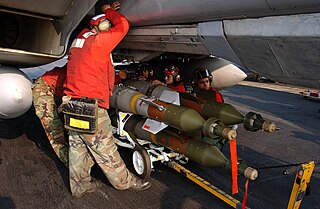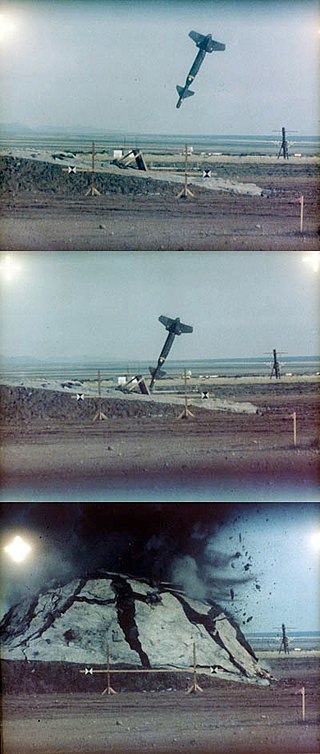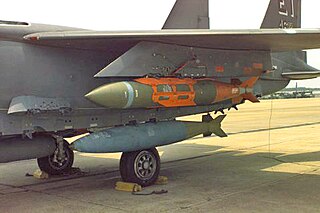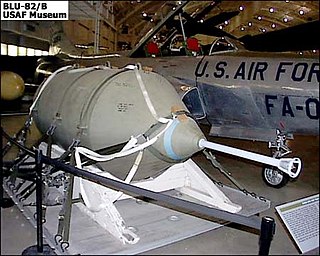Related Research Articles

The Lockheed F-117 Nighthawk is a retired American single-seat, subsonic twin-engine stealth attack aircraft developed by Lockheed's secretive Skunk Works division and operated by the United States Air Force (USAF). It was the first operational aircraft to be designed with stealth technology.
A bunker buster is a type of munition that is designed to penetrate hardened targets or targets buried deep underground, such as military bunkers.
The GBU-10 Paveway II is an American Paveway-series laser-guided bomb, based on the Mk 84 general-purpose bomb, but with laser seeking capabilities and wings for guidance. Introduced into service c. 1976, it is used today by USAF, US Navy, US Marine Corps, Royal Australian Air Force and various NATO air forces.

The GBU-12 Paveway II is an American aerial laser-guided bomb, based on the Mk 82 500-pound (227 kg) general-purpose bomb, but with the addition of a nose-mounted laser seeker and fins for guidance. A member of the Paveway series of weapons, Paveway II entered into service c. 1976. It is currently in service with the U.S. Air Force, U.S. Navy, U.S. Marine Corps, and various other air forces.
The GBU-28 is a 4,000-pound (1814.3 kg) class laser-guided "bunker busting" bomb produced originally by the Watervliet Arsenal, Watervliet, New York. It was designed, manufactured, and deployed in less than three weeks due to an urgent need during Operation Desert Storm to penetrate hardened Iraqi command centers located deep underground. Only two of the weapons were dropped in Desert Storm, both by F-111Fs. One GBU-28 was dropped during Operation Iraqi Freedom.
The Mark 84 or BLU-117 is a 2,000-pound (900 kg) American general-purpose bomb. It is the largest of the Mark 80 series of weapons. Entering service during the Vietnam War, it became a commonly used US heavy unguided bomb to be dropped. At the time, it was the third largest bomb by weight in the US inventory behind the 15,000-pound (6,800 kg) BLU-82 "Daisy Cutter" and the 3,000-pound (1,400 kg) M118 "demolition" bomb. It is currently sixth in size due to the addition of the 5,000 lb (2,300 kg) GBU-28 in 1991, the 22,600 lb (10,300 kg) GBU-43/B Massive Ordnance Air Blast bomb (MOAB) in 2003, and the 30,000 lb (14,000 kg) Massive Ordnance Penetrator.

The Mark 83 is a 1,000-pound (450 kg) bomb, part of the Mark 80 series of low-drag general-purpose bombs in United States service.
The GBU-27 Paveway III is a laser-guided bomb with bunker buster capabilities, it is a GBU-24 Paveway III that has been redesigned to be used by the F-117A Nighthawk stealth ground attack aircraft. The pilots flying over Iraq during the First Gulf War nicknamed it the "Hammer", for its considerable destructive power and blast radius.

GBU-24 Paveway III or simply GBU-24 is a family of laser-guided bombs, a sub-group of the larger Raytheon Paveway III family of weapons. The Paveway guidance package consists of a seeker package attached to the nose of the weapon, and a wing kit attached to the rear to provide stability and greater range.
The Mark 82 is a 500-pound (230 kg) unguided, low-drag general-purpose bomb, part of the United States Mark 80 series. The explosive filling is usually tritonal, though other compositions have sometimes been used.
The Joint Direct Attack Munition (JDAM) is a guidance kit that converts unguided bombs, or "dumb bombs", into all-weather precision-guided munitions. JDAM-equipped bombs are guided by an integrated inertial guidance system coupled to a Global Positioning System (GPS) receiver, giving them a published range of up to 15 nautical miles (28 km). JDAM-equipped bombs range from 500 to 2,000 pounds. The JDAM's guidance system was jointly developed by the United States Air Force and United States Navy, hence the "joint" in JDAM. When installed on a bomb, the JDAM kit is given a GBU identifier, superseding the Mark 80 or BLU nomenclature of the bomb to which it is attached.

Paveway is a series of laser-guided bombs (LGBs).

A general-purpose bomb is an air-dropped bomb intended as a compromise between blast damage, penetration, and fragmentation in explosive effect. They are designed to be effective against enemy troops, vehicles, and buildings.

The BLU-109/B is a hardened penetration bomb used by the United States Air Force. As with other "bunker busters", it is intended to penetrate concrete shelters and other hardened structures before exploding. In addition to the US, it is part of the armament of the air forces of Australia, Belgium, Canada, Denmark, France, Germany, Greece, Italy, Israel, Netherlands, Norway, Pakistan, Saudi Arabia, United Kingdom and United Arab Emirates.

The BLU-82B/C-130 weapon system, known under program "Commando Vault" and nicknamed "Daisy Cutter" in Vietnam for its ability to flatten a section of forest into a helicopter landing zone, was an American 15,000-pound (6,800 kg) conventional bomb, delivered from either a C-130 or MC-130 transport aircraft or a CH-54 heavy-lift "Skycrane" helicopter from the 1st Air Cavalry. A total of 225 were constructed. It was successfully used during military operations in Vietnam, the Gulf War and Afghanistan. The BLU-82 was retired in 2008 and replaced with the more powerful GBU-43/B MOAB.

The GBU-57A/BMassive Ordnance Penetrator (MOP) is a precision-guided, 30,000-pound (14,000 kg) "bunker buster" bomb used by the United States Air Force. It is substantially larger than the deepest-penetrating bunker busters previously available, the 5,000-pound (2,300 kg) GBU-28 and GBU-37.

A guided bomb is a precision-guided munition designed to achieve a smaller circular error probable (CEP).

A precision-guided munition (PGM), also called a smart weapon, smart munition, or smart bomb, is a guided munition intended to hit a specific target, to minimize collateral damage and increase lethality against intended targets. During the Persian Gulf War guided munitions accounted for only 9% of weapons fired, but accounted for 75% of all successful hits. Despite guided weapons generally being used on more difficult targets, they were still 35 times more likely to destroy their targets per weapon dropped.
References
- 1 2 3 BLU-116 Advanced Unitary Penetrator (AUP) GBU-24 C/B (USAF) / GBU-24 D/B (Navy) Specifications, accessed Oct 2, 2007
- 1 2 BLU-116 Advanced Unitary Penetrator (AUP) GBU-24 C/B (USAF) / GBU-24 D/B (Navy), accessed Oct 2, 2007